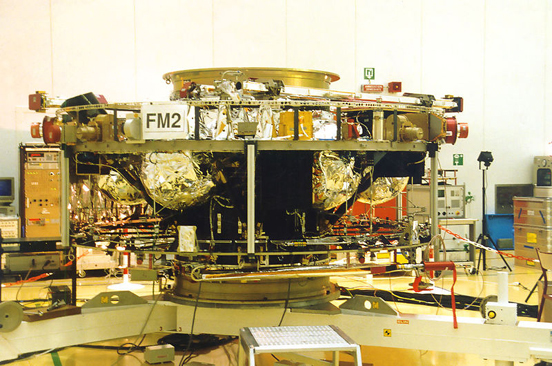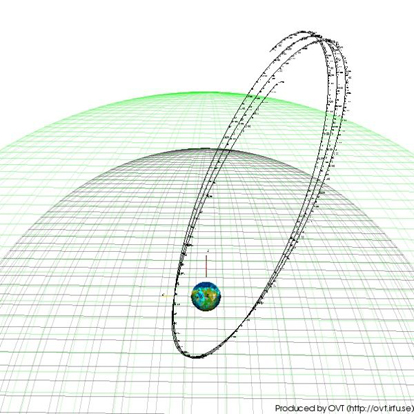 |
|
By
Wikipedia,
the free encyclopedia,
http://en.wikipedia.org/wiki/Cluster_mission  | |
Cluster satellite FM2 |
The Cluster mission is a European Space Agency (ESA) unmanned space mission to study the Earth's magnetosphere using four identical spacecraft flying in a tetrahedral formation. The first four Cluster spacecraft were lost in the Ariane 5 flight failure on 1996 June 4, leading to the construction of four new spacecraft and their successful launching in 2000 on Soyuz-Fregat rockets.
Cluster Mission Overview
 | |
Cluster orbit during one week from March 21, 2004, viewed from the north ecliptic pole. The wire grids represent average positions of the bow shock (outer, green) and the magnetopause (inner, blue) of the Earth's magnetosphere. Because of Earth's motion around the Sun, the spacecraft orbit appears to turn in this figure, where the direction to the Sun is upward. |
The four identical Cluster satellites research the protective magnetosphere of the Earth that shields us from the continual solar wind. Cluster FM5 to FM8 (FM1 to FM4 were lost in the 1996 failed launch) measure three dimensional data from the collision of the solar wind with the Earth's magnetic field, its changes over time and the effects on near-Earth space and its atmosphere, including aurorae.
The spacecraft are cylindrical (290 x 130 cm, see [1]) and are spin-stabilized at 15 rotations per minute. Their solar cells provide 224 watts power for instruments and communications. The four spacecraft maneuver into various tetrahedral formations in order to study the magnetospheric structure and boundaries. The inter-spacecraft distances can be varied from around 100 to 10000 kilometers (km). The propellant for the maneuvers makes up approximately half of the spacecraft's launch weight.
The highly elliptical orbits of the spacecraft reach a perigee of around 4 RE (Earth radii, where 1 RE = 6371 km) and an apogee of 19.6 RE. Each orbit takes approximately 57 hours to complete. The European Space Operations Centre (ESOC) acquires telemetry and distributes the science data from the spacecraft online.
History
The Cluster mission was proposed to ESA in 1982 and approved in 1986, along with the Solar and Heliospheric Observatory (SOHO). Though the original Cluster spacecraft were completed in 1995, the explosion of the rocket carrying the satellites in 1996 delayed the mission for another four years while the instruments were rebuilt.
On 16 July 2000, a Soyuz-Fregat rocket from the Baikonur Cosmodrome launched two of the Clusters (Salsa and Samba) into a parking orbit from where they maneuvered under their own power into a 19,000 by 119,000 kilometer orbit with a period of 57 hours. Three weeks later on 9 August 2000 another Soyuz-Fregat rocket lifted the remaining two Cluster spacecraft (Rumba and Tango) into similar orbits. Spacecraft 1, Rumba, is also known as the Phoenix spacecraft, since it is largely built from spare parts left over after the failure of the original mission. After commissioning of the payload, the first scientific measurements were officially made on 1 February 2001.
The ESA ran a competition to name the Cluster satellites, which attracted participants from many countries. Ray Cotton from the United Kingdom won with the names Rumba, Tango, Salsa and Samba. Ray's town of residence, Bristol, was awarded with scale models of the satellites in recognition of the naming and connection with the satellites.
Originally planned to last until the end of 2003, the mission has now been extended three times. The first extension took the mission from 2004 until 2005, the second from 2005 to June 2009 and the third to the end of 2009.
Scientific Objectives
Previous single and two spacecraft missions were not capable of providing the data required to accurately study the boundaries of the magnetosphere. Because the plasma comprising the magnetosphere cannot presently be accessed using remote sensing techniques, satellites must be used to measure it in-situ. Four spacecraft allow scientists make the 3D, time-resolved measurements needed to create a realistic picture of the complex plasma interactions occurring between regions of the magnetosphere and between the magnetosphere and the solar wind.
Each satellite carries a scientific payload of 11 instruments designed to study the small-scale plasma structures in space and time in the key plasma regions: the solar wind and bow shock, magnetopause, polar cusps, magnetotail and the auroral zone.
- The bow shock (see illustration to the right) is the region in space between the Earth and the sun where the solar wind decelerates from super- to sub-sonic before being deflected around the Earth. In traversing this region, Cluster makes measurements which help characterize processes occurring at the bow shock, such as the origin of hot flow anomalies and the transmission of electromagnetic waves through through the bow shock and the magnetosheath from the solar wind.
- Behind the bow shock is the thin plasma layer separating the Earth and solar wind magnetic fields known as the magnetopause. This boundary moves continuously due to the constant variation in solar wind pressure. Since the plasma and magnetic pressures within the solar wind and the magnetosphere, respectively, should be in equilibrium, the magnetosphere should be an impenetrable boundary. However, plasma has been observed crossing the magnetopause into the magnetosphere from the solar wind. Cluster's four-point measurements make it possible to track the motion of the magnetopause as well as elucidate the mechanism for plasma penetration from the solar wind.
- In two regions, one in the northern hemisphere and the other in the south, the magnetic field of the Earth is perpendicular rather than tangential to the magnetopause. These polar cusps allow solar wind particles, consisting of ions and electrons, to flow into the magnetosphere. Cluster records the particle distributions, which allow the turbulent regions at the exterior cusps to be characterized.
- The regions of the Earth's magnetic field that are stretched by the solar wind away from the sun are known collectively as the magnetotail. Two lobes that reach past the Moon in length form the outer magnetotail while the central plasma sheet forms the inner magnetotail, which is highly active. Cluster monitors particles from the ionosphere and the solar wind as they pass through the magnetotail lobes. In the central plasma sheet, Cluster determines the origins of ion beams and disruptions to the magnetic field-aligned currents caused by substorms.
- The precipitation of charged particles in the atmosphere creates a ring of light emission around the magnetic pole known as the auroral zone. Cluster measures the time variations of transient particle flows in the region.
Instrumentation
Details of the 11 instruments aboard each of the four Cluster spacecraft are provided in the table below. Briefly, the instruments are dedicated to measuring the electric (E) and magnetic (B) field magnitudes and directions and the densities and distributions of particles (electrons and ions) in the plasma.
| Number |
Acronym |
Instrument |
Measurement |
Purpose |
| 1 |
FGM |
Fluxgate Magnetometer |
Magnetic field B magnitude and direction |
B vector and event trigger to all instruments except ASPOC |
| 2 |
EFW |
Electric Field and Wave experiment |
Electric field E magnitude and direction |
E vector, spacecraft potential, electron density and temperature |
| 3 |
STAFF |
Spatio-Temporal Analysis of Field Fluctuation experiment |
Magnetic field B magnitude and direction of EM fluctuations, cross-correlation of E and B |
Properties of small-scale current structures, source of plasma waves and turbulence |
| 4 |
WHISPER |
Waves of High Frequency and Sounder for Probing of Density by Relaxation |
In active mode, total electron density ρ; in passive mode, neutral plasma waves |
Plasma density ρ measurements unaffected by fluctuations in spacecraft potential |
| 5 |
WBD |
Wide Band Data receiver |
Electric field E waveforms and spectrograms of terrestrial plasma waves and radio emissions |
Motion of terrestrial fluctuations, e.g. auroral kilometric radiation |
| 6 |
DWP |
Digital Wave Processing instrument |
Data manipulation |
Control over and communication between instruments 2-5 to yield particle correlations |
| 7 |
EDI |
Electron Drift Instrument |
Electric field E magnitude and direction |
E vector, gradients in local magnetic field B |
| 8 |
ASPOC |
Active Spacecraft Potential Control experiment |
Regulation of spacecraft's electrostatic potential |
Control over and communication between instruments 2-5 and 10 |
| 9 |
CIS |
Cluster Ion Spectroscopy experiment |
Ion times-of-flight (TOFs) and energies from 0 to 40 keV |
Composition and 3D distribution of ions in plasma |
| 10 |
PEACE |
Plasma Electron and Current Experiment |
Electron energies from 0.0007 to 30 keV |
3D distribution of electrons in plasma |
| 11 |
RAPID |
Research with Adaptive Particle Imaging Detectors |
Electron energies from 30 to 1500 keV, ion energies from 20 to 450 keV |
3D distributions of high-energy electrons and ions in plasma |
- ^ Plot produced using the Orbit Visualization Tool.
- ^ ed. Paschmann, G.; Schwartz, S.J.; Escoubet, C.P.; Haaland S. Outer Magnetospheric Boundaries: Cluster Results, Springer, Dordrecht, The Netherlands, 2005.
- ^ ed. Escoubet, CP; Russell, CT; Schmidt, R. The Cluster and Phoenix Missions, Kluwer Academic Publishers, Dordrecht, Belgium, 1997.
Chinese "Double Star" Mission: 2003
In late 2003 and the middle of 2004 the China National Space Administration launched the Double Star satellites that work together with Cluster to make synchronous measurements of the magnetosphere at much greater spacecraft separations.
Partial list of discoveries
2002
- March 9 - discovery of vortices ranging in size from 40,000 down to around 100 kilometres in Earth's polar magnetic field
- April 20 - The first direct measurements of Earth's ring current density
2003
- May 20 - Cluster observes 'reverse reconnection', simultaneously with a bright proton aurora observed by IMAGE.
2004
- April 5 - The first unambiguous measurements of the thickness of the Earth's Bow Shock.
- December 12 - Cluster determines the spatial scale of highspeed flows in the magnetotail.
2005
- December 5 - Cluster helps predict 'killer electrons'.
2006
- July 18 - Cluster observes the 'magnetic heart' of reconnection in the magnetotail.
- July 20 - Cluster and Double Star discover density holes in the solar wind.
2007
2008
External links
Text from Wikipedia is available under the Creative Commons Attribution/Share-Alike License; additional terms may apply.
Published in July 2009.
Click here to read more articles related to aviation and space!
|
 |



